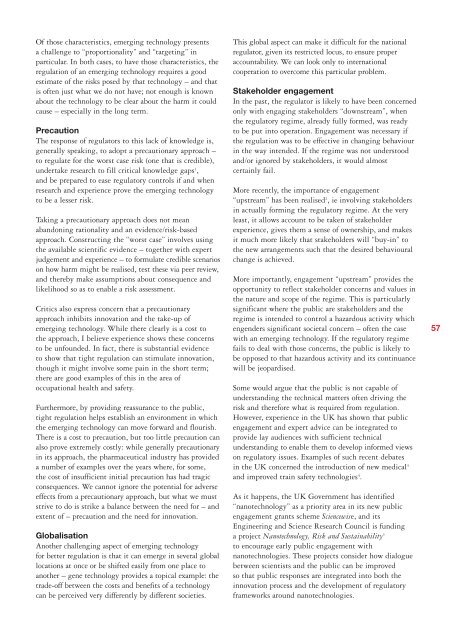Small size - large impact - Nanowerk
Small size - large impact - Nanowerk
Small size - large impact - Nanowerk
You also want an ePaper? Increase the reach of your titles
YUMPU automatically turns print PDFs into web optimized ePapers that Google loves.
Of those characteristics, emerging technology presents<br />
a challenge to “proportionality” and “targeting” in<br />
particular. In both cases, to have those characteristics, the<br />
regulation of an emerging technology requires a good<br />
estimate of the risks posed by that technology – and that<br />
is often just what we do not have; not enough is known<br />
about the technology to be clear about the harm it could<br />
cause – especially in the long term.<br />
Precaution<br />
The response of regulators to this lack of knowledge is,<br />
generally speaking, to adopt a precautionary approach –<br />
to regulate for the worst case risk (one that is credible),<br />
undertake research to fill critical knowledge gaps 1 ,<br />
and be prepared to ease regulatory controls if and when<br />
research and experience prove the emerging technology<br />
to be a lesser risk.<br />
Taking a precautionary approach does not mean<br />
abandoning rationality and an evidence/risk-based<br />
approach. Constructing the “worst case” involves using<br />
the available scientific evidence – together with expert<br />
judgement and experience – to formulate credible scenarios<br />
on how harm might be realised, test these via peer review,<br />
and thereby make assumptions about consequence and<br />
likelihood so as to enable a risk assessment.<br />
Critics also express concern that a precautionary<br />
approach inhibits innovation and the take-up of<br />
emerging technology. While there clearly is a cost to<br />
the approach, I believe experience shows these concerns<br />
to be unfounded. In fact, there is substantial evidence<br />
to show that tight regulation can stimulate innovation,<br />
though it might involve some pain in the short term;<br />
there are good examples of this in the area of<br />
occupational health and safety.<br />
Furthermore, by providing reassurance to the public,<br />
tight regulation helps establish an environment in which<br />
the emerging technology can move forward and flourish.<br />
There is a cost to precaution, but too little precaution can<br />
also prove extremely costly: while generally precautionary<br />
in its approach, the pharmaceutical industry has provided<br />
a number of examples over the years where, for some,<br />
the cost of insufficient initial precaution has had tragic<br />
consequences. We cannot ignore the potential for adverse<br />
effects from a precautionary approach, but what we must<br />
strive to do is strike a balance between the need for – and<br />
extent of – precaution and the need for innovation.<br />
Globalisation<br />
Another challenging aspect of emerging technology<br />
for better regulation is that it can emerge in several global<br />
locations at once or be shifted easily from one place to<br />
another – gene technology provides a topical example: the<br />
trade-off between the costs and benefits of a technology<br />
can be perceived very differently by different societies.<br />
This global aspect can make it difficult for the national<br />
regulator, given its restricted locus, to ensure proper<br />
accountability. We can look only to international<br />
cooperation to overcome this particular problem.<br />
Stakeholder engagement<br />
In the past, the regulator is likely to have been concerned<br />
only with engaging stakeholders “downstream”, when<br />
the regulatory regime, already fully formed, was ready<br />
to be put into operation. Engagement was necessary if<br />
the regulation was to be effective in changing behaviour<br />
in the way intended. If the regime was not understood<br />
and/or ignored by stakeholders, it would almost<br />
certainly fail.<br />
More recently, the importance of engagement<br />
“upstream” has been realised 2 , ie involving stakeholders<br />
in actually forming the regulatory regime. At the very<br />
least, it allows account to be taken of stakeholder<br />
experience, gives them a sense of ownership, and makes<br />
it much more likely that stakeholders will “buy-in” to<br />
the new arrangements such that the desired behavioural<br />
change is achieved.<br />
More importantly, engagement “upstream” provides the<br />
opportunity to reflect stakeholder concerns and values in<br />
the nature and scope of the regime. This is particularly<br />
significant where the public are stakeholders and the<br />
regime is intended to control a hazardous activity which<br />
engenders significant societal concern – often the case<br />
with an emerging technology. If the regulatory regime<br />
fails to deal with those concerns, the public is likely to<br />
be opposed to that hazardous activity and its continuance<br />
will be jeopardised.<br />
Some would argue that the public is not capable of<br />
understanding the technical matters often driving the<br />
risk and therefore what is required from regulation.<br />
However, experience in the UK has shown that public<br />
engagement and expert advice can be integrated to<br />
provide lay audiences with sufficient technical<br />
understanding to enable them to develop informed views<br />
on regulatory issues. Examples of such recent debates<br />
in the UK concerned the introduction of new medical 3<br />
and improved train safety technologies 4 .<br />
As it happens, the UK Government has identified<br />
“nanotechnology” as a priority area in its new public<br />
engagement grants scheme Sciencewise, and its<br />
Engineering and Science Research Council is funding<br />
a project Nanotechnology, Risk and Sustainability 5<br />
to encourage early public engagement with<br />
nanotechnologies. These projects consider how dialogue<br />
between scientists and the public can be improved<br />
so that public responses are integrated into both the<br />
innovation process and the development of regulatory<br />
frameworks around nanotechnologies.<br />
57
















